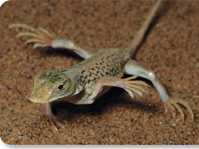Body Temperature Control
 How do animals control their body temperature?
How do animals control their body temperature?
Control of body temperature is important for maintaining homeostasis, particularly in areas where temperature varies widely with time of day and with season. Why is temperature control so important? Because many body functions are influenced by temperature. For example, muscles cannot operate if they are too cold or too hot. Cold muscles contract slowly, making an animal slow to react. If muscles get too hot, on the other hand, they may tire easily.
Body temperature control requires three components: a source of heat, a way to conserve heat when necessary, and a method of eliminating excess heat when necessary. An animal may be described as an ectotherm or endotherm based on the structures and behaviors that enable it to control its body temperature.

FIGURE 28–27 Ectotherm This shovel-snouted lizard, an ectotherm, lives in the Namib Desert in Africa, one of the hottest places on Earth. It is regulating its body temperature by stilting—raising its body off the hot sand by performing a sort of push-up. Infer Do you think stilting is more likely to raise or lower body temperature? Explain.
Ectotherms On cool, sunny mornings, lizards bask in the sun. This doesn't mean that they are lazy! A lizard is an ectotherm—an animal whose regulation of body temperature depends mostly on its relationship to sources of heat outside its body.  Most reptiles, invertebrates, fishes, and amphibians are ectotherms that regulate body temperature primarily by absorbing heat from, or losing heat to, their environment.
Most reptiles, invertebrates, fishes, and amphibians are ectotherms that regulate body temperature primarily by absorbing heat from, or losing heat to, their environment.
Ectotherms have relatively low metabolic rates when resting, so their bodies don't generate much heat. When active, their muscles generate heat, just as your muscles do. However, most ectotherms lack effective body insulation, so their body heat is easily lost to the environment. That's why ectotherms warm up by basking in the sun. They also have to regulate their body temperature in hot conditions. The lizard in Figure 28–27 is “stilting” to cool off. Ectotherms also often use underground burrows, where there are fewer temperature extremes. On hot, sunny days, they might seek shelter in a burrow that is cooler than the land surface. On chilly nights, those same burrows are warmer than the surface, enabling the animal to conserve some body heat.
 In Your Notebook Explain in your own words why the word coldblooded is an incorrect way to describe an ectotherm.
In Your Notebook Explain in your own words why the word coldblooded is an incorrect way to describe an ectotherm.
Endotherms An endotherm is an animal whose body temperature is regulated, at least in part, using heat generated by its body.  Endotherms, such as birds and mammals, have high metabolic rates that generate heat, even when they are resting. Birds conserve body heat primarily with insulating feathers, such as fluffy down. Mammals use combinations of body fat and hair for insulation. Some birds and most mammals can get rid of excess heat by panting, as the dingo in Figure 28–28 is doing. Humans sweat to help reduce their body temperature. As sweat evaporates, it removes heat from the skin and the blood in capillaries just under the surface of the skin. Thus, as warm blood flows through the cooled capillaries, it loses heat.
Endotherms, such as birds and mammals, have high metabolic rates that generate heat, even when they are resting. Birds conserve body heat primarily with insulating feathers, such as fluffy down. Mammals use combinations of body fat and hair for insulation. Some birds and most mammals can get rid of excess heat by panting, as the dingo in Figure 28–28 is doing. Humans sweat to help reduce their body temperature. As sweat evaporates, it removes heat from the skin and the blood in capillaries just under the surface of the skin. Thus, as warm blood flows through the cooled capillaries, it loses heat.

FIGURE 28–28 Endotherm Many endotherms, such as this dingo, pant when they are very warm. Panting allows air to evaporate some of the moisture in the blood-vessel rich mouth and respiratory tract, cooling the blood.
Table of Contents
- Formulas and Equations
- Applying Formulas and Equations
- Mean, Median, and Mode
- Estimation
- Using Measurements in Calculations
- Effects of Measurement Errors
- Accuracy
- Precision
- Comparing Accuracy and Precision
- Significant Figures
- Calculating With Significant Figures
- Scientific Notation
- Calculating With Scientific Notation
- Dimensional Analysis
- Applying Dimensional Analysis




